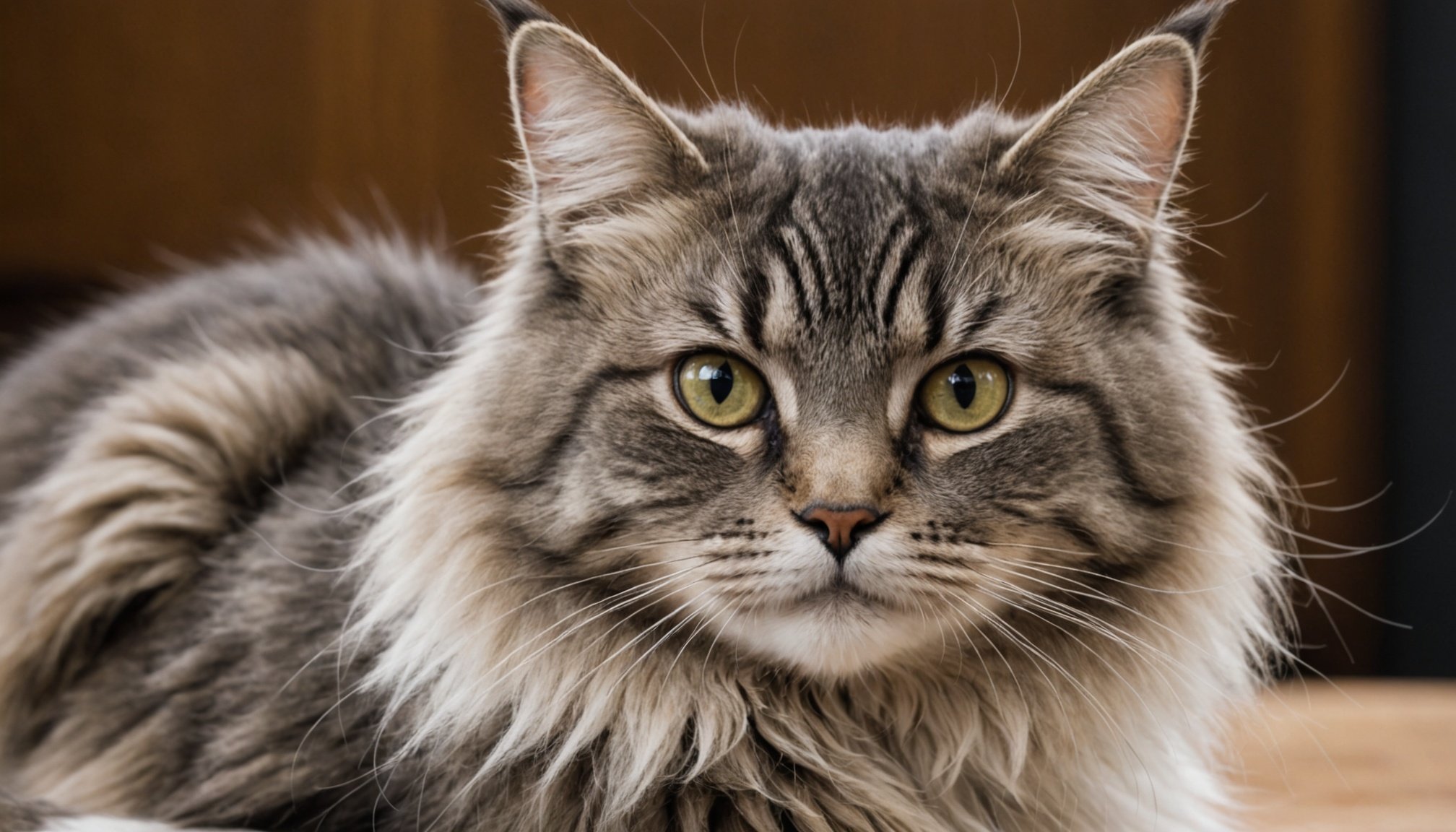Ultimate Guide to Preventing and Managing Fur Matting in Long-Haired Cats: Tips and Tricks for Happy Grooming
Why Grooming is Crucial for Your Long-Haired Cat
Grooming is an essential part of cat care, especially for long-haired cats. These beautiful felines, with their lush and silky coats, require regular attention to prevent matting and tangling, which can be painful and even harmful to their health.
“When you groom your cat, you’re not just making them look good; you’re also ensuring their overall health and well-being,” says Dr. Jane Smith, a veterinarian specializing in feline care. “Matting and tangling can cause skin irritation, infections, and even affect your cat’s mobility.”
Understanding the Basics of Cat Grooming
Before diving into the specifics of managing fur matting, it’s important to understand the basics of cat grooming.
Choosing the Right Grooming Tools
The right tools can make all the difference in grooming your long-haired cat. Here are some essential tools you’ll need:
Also read : Proven Techniques to Alleviate Your Cat’s Anxiety During Veterinary Appointments
- Brushes: There are various types of brushes, but for long-haired cats, a slicker brush or a pin brush is ideal. These brushes have long bristles that can reach deep into the coat to remove loose hair and prevent matting[1].
- Combs: A wide-tooth comb or a detangling comb is perfect for gently working out knots and mats without causing discomfort to your cat.
- Nail Trimmers: Keeping your cat’s nails trimmed is crucial to prevent them from getting caught in the fur and causing mats.
- Ear Cleaning Tools: Clean ears are essential for your cat’s health, and using the right tools can help prevent infections.
Creating a Grooming Routine
Establishing a regular grooming routine is key to preventing matting and ensuring your cat’s coat remains healthy.
- Frequency: For long-haired cats, grooming sessions should be almost daily. This can be as simple as a quick brush-through or a more thorough session depending on your cat’s needs.
- Patience: Not all cats enjoy grooming, so it’s important to start slowly and build up to more extensive sessions. Begin with short sessions and gradually increase the duration as your cat becomes more comfortable.
- Timing: Try to groom your cat when they are most relaxed, such as after a meal or a nap. Avoid grooming when they are stressed or anxious.
Preventing Fur Matting
Preventing fur matting is much easier than dealing with it after it has formed. Here are some tips to help you keep your long-haired cat’s coat mat-free:
Regular Brushing
Regular brushing is the most effective way to prevent matting. Here’s how you can incorporate brushing into your routine:
- Daily Brushing: Use a brush or comb specifically designed for long-haired cats to remove loose hair and prevent tangles.
- Focus on Trouble Areas: Pay special attention to areas prone to matting, such as the armpits, behind the ears, and around the base of the tail.
- Be Gentle: Always brush in the direction of the hair growth to avoid causing discomfort or pain to your cat.
Environmental Care
The environment your cat lives in can also impact their coat health. Here are a few tips to keep in mind:
- Clean Your Home: Regularly clean your home to reduce dust and dander, which can contribute to matting.
- Provide a Healthy Environment: Ensure your cat has a clean and comfortable place to rest. Regularly wash their bedding and keep their living area free from debris[1].
Managing Existing Mats and Tangles
Despite your best efforts, mats and tangles can still form. Here’s how you can manage them:
Identifying Mats and Tangles
Before you start, it’s important to identify where the mats and tangles are. Here are some signs to look out for:
- Visible Knots: Mats and tangles can be visible, especially in areas where the fur is longest.
- Behavioral Changes: If your cat is avoiding certain areas or seems uncomfortable, it could be a sign of matting.
- Skin Irritation: Check for any signs of skin irritation or redness, which can be caused by matting.
Tools and Techniques for Removing Mats
Here are some tools and techniques to help you remove mats and tangles safely:
- Detangling Sprays: Use a detangling spray to help loosen the mats and make them easier to comb out.
- Wide-Tooth Combs: A wide-tooth comb is gentle on your cat’s skin and can help work out knots without causing pain.
- Bicarbonate of Soda: For particularly stubborn mats, you can try using bicarbonate of soda. Sprinkle it on the mat, gently rub it in, and then brush it out. This helps to absorb excess oil and loosen the mat[1].
When to Seek Professional Help
Sometimes, mats can be too severe to handle on your own. Here are some signs that you might need professional help:
- Severe Matting: If the mats are very tight and close to the skin, it may be best to seek the help of a professional groomer or veterinarian.
- Skin Irritation: If you notice any signs of skin irritation or infection, it’s crucial to get professional advice.
- Behavioral Issues: If your cat is showing signs of distress or avoiding grooming altogether, it may be a sign that they need professional attention.
Additional Grooming Tips for Long-Haired Cats
Grooming is not just about preventing matting; it’s also about maintaining your cat’s overall health and hygiene. Here are some additional tips:
Nail Trimming
Long-haired cats can sometimes get their nails caught in their fur, leading to matting. Regular nail trimming can help prevent this.
- Frequency: Trim your cat’s nails every few weeks, or as needed.
- Technique: Use nail trimmers specifically designed for cats, and trim just the tip of the nail to avoid cutting the quick.
Ear Cleaning
Clean ears are essential for your cat’s health. Here’s how you can clean their ears safely:
- Frequency: Clean your cat’s ears weekly.
- Tools: Use ear cleaning solution and cotton balls. Gently wipe the outer ear and avoid inserting the cotton ball into the ear canal.
Dental Care
While not directly related to fur matting, dental care is an important part of overall grooming.
- Brushing Teeth: Use a cat-specific toothbrush and toothpaste to brush your cat’s teeth regularly.
- Dental Chews: Provide dental chews to help remove plaque and tartar.
Practical Insights and Actionable Advice
Here are some practical insights and actionable advice to help you in your grooming journey:
Building a Grooming Routine
Creating a routine can make grooming easier and more enjoyable for both you and your cat.
- Start with short sessions (5-10 minutes) and gradually increase the duration.
- Choose a quiet, comfortable space for grooming.
- Reward your cat with treats and praise for good behavior.
Choosing the Right Products
The right products can make a big difference in grooming.
| Product | Description | Benefits |
|---|---|---|
| Slicker Brush | Long bristles, ideal for long-haired cats | Removes loose hair, prevents matting |
| Wide-Tooth Comb | Gentle on skin, wide spaces between teeth | Works out knots and mats without causing pain |
| Detangling Spray | Helps loosen mats and tangles | Makes combing easier, reduces pain and discomfort |
| Nail Trimmers | Specifically designed for cats | Prevents nails from getting caught in fur |
| Ear Cleaning Solution | Gentle, safe for cats | Keeps ears clean, prevents infections |
Common Mistakes to Avoid
Here are some common mistakes to avoid when grooming your long-haired cat:
- Brushing Against the Grain: Always brush in the direction of hair growth to avoid causing discomfort or pain.
- Using Human Products: Never use human grooming products on your cat, as they can be harmful.
- Ignoring Trouble Areas: Pay special attention to areas prone to matting, such as the armpits and behind the ears.
Grooming your long-haired cat is a rewarding experience that not only keeps their coat healthy and beautiful but also strengthens the bond between you and your pet. By following these tips and tricks, you can prevent fur matting, manage existing mats, and ensure your cat remains happy and healthy.
“Remember, grooming is not just about the physical health of your cat; it’s also about their emotional well-being. A well-groomed cat is a happy cat,” advises Dr. Jane Smith.
By incorporating regular grooming sessions into your routine, using the right tools, and being patient and gentle, you can help your long-haired cat enjoy a life free from the discomfort and health issues associated with fur matting.


